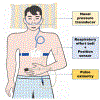Investigation of Snoring and Obstructive Sleep Apnea Using Portable Polysomnography in Patients with Temporomandibular Disorder
- PMID: 36276181
- PMCID: PMC9583762
- DOI: 10.26502/droh.0050
Investigation of Snoring and Obstructive Sleep Apnea Using Portable Polysomnography in Patients with Temporomandibular Disorder
Abstract
Objective: To investigate snoring and obstructive sleep apnea (OSA) in patients with temporomandibular disorder (TMD) using portable polysomnography and identify sex-based differences in clinical features and sleep-related results.
Methods: Seventy consecutive patients (44 female; mean age, 46.6918.18 years) with myofascial pain-associated TMD, diagnosed based on the criteria for TMD Axis I, were enrolled. Sleep quality and quantity were measured using portable polysomnography. Clinical characteristics were investigated using well-structured standardized reports on clinical signs and symptoms, questionnaires, and clinical examination by TMD specialists.
Results: Among 70 TMD patients, 50.0% had OSA and 15.7% had snoring, with no sex-based differences. The mean Mallampati scores for OSA prediction (2.69±1.12 vs. 1.70±0.82, p<0.001), mean body mass index (BMI) (24.94±1.78 vs. 22.02±2.24, p<0.001), and ratio of overweight patients (57.7 vs. 11.4%) with BMI ≥25 were significantly higher in males than in females (all p<0.001). Conversely, the mixed sleep apnea index was significantly higher in females than in males (0.81±0.80 vs. 0.44±0.54, p=0.022). Female sex was associated with the absence of snoring (OR=0.146, p=0.022). Based on the area under curve (AUC) value for snoring prediction, Mallampati score was the strongest predictor (AUC>0.932, p<0.001), followed by BMI, overweight, and obstructive sleep apnea index (AUC>0.8, all p<0.001).
Conclusions: Our results support the necessity of investigating sex-based differences when examining sleep problems, including snoring and OSA, in TMD patients. Mallampati scoring could be a useful tool for physical examination prior to polysomnography. Sleep and biopsychosocial factors are important for the diagnosis and treatment of TMD.
Keywords: Mallampati score; Obstructive sleep apnea; Overweight; Polysomnography; Snoring; Temporomandibular disorder.
Conflict of interest statement
Competing interest statement The authors declare no competing interests.
Figures



Similar articles
-
Automatic prediction of obstructive sleep apnea in patients with temporomandibular disorder based on multidata and machine learning.Sci Rep. 2024 Aug 21;14(1):19362. doi: 10.1038/s41598-024-70432-4. Sci Rep. 2024. PMID: 39169169 Free PMC article.
-
Persistent snoring under conscious sedation during colonoscopy is a predictor of obstructive sleep apnea.Gastrointest Endosc. 2010 Jun;71(7):1224-30. doi: 10.1016/j.gie.2009.11.049. Epub 2010 Mar 20. Gastrointest Endosc. 2010. PMID: 20304398
-
Sleep analysis results of portable polysomnography in patients with acute and chronic temporomandibular disorder.Dent Res Oral Health. 2022;5(4):83-93. doi: 10.26502/droh.0052. Epub 2022 Oct 7. Dent Res Oral Health. 2022. PMID: 36330079 Free PMC article.
-
Automatic detection of obstructive sleep apnea based on speech or snoring sounds: a narrative review.J Thorac Dis. 2024 Apr 30;16(4):2654-2667. doi: 10.21037/jtd-24-310. Epub 2024 Apr 29. J Thorac Dis. 2024. PMID: 38738242 Free PMC article. Review.
-
Associations between obstructive sleep apnea and painful temporomandibular disorder: a systematic review.J Korean Assoc Oral Maxillofac Surg. 2022 Oct 31;48(5):259-266. doi: 10.5125/jkaoms.2022.48.5.259. J Korean Assoc Oral Maxillofac Surg. 2022. PMID: 36316183 Free PMC article. Review.
Cited by
-
Automatic prediction of obstructive sleep apnea in patients with temporomandibular disorder based on multidata and machine learning.Sci Rep. 2024 Aug 21;14(1):19362. doi: 10.1038/s41598-024-70432-4. Sci Rep. 2024. PMID: 39169169 Free PMC article.
References
-
- List T & Jensen RH Temporomandibular disorders: Old ideas and new concepts. Cephalalgia 37 (2017): 692–704. - PubMed
Grants and funding
LinkOut - more resources
Full Text Sources
